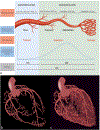Cardiovascular Imaging Techniques to Assess Microvascular Dysfunction
- PMID: 31607665
- PMCID: PMC7148179
- DOI: 10.1016/j.jcmg.2019.09.006
Cardiovascular Imaging Techniques to Assess Microvascular Dysfunction
Abstract
The understanding of microvascular dysfunction without evidence of epicardial coronary artery disease pales in comparison with that of obstructive epicardial coronary artery disease. A primary limitation in the past had been the lack of development of noninvasive methods of detecting and quantifying microvascular dysfunction. This limitation has particularly affected the ability to study the pathophysiology, morbidity, and treatment of this disease. More recently, almost all of the noninvasive cardiac imaging modalities have been used to quantify blood flow and advance understanding of microvascular dysfunction.
Keywords: cardiac magnetic resonance; computed tomography; echocardiography; microvascular dysfunction; positron emission tomography; quantitative perfusion.
Copyright © 2020 American College of Cardiology Foundation. Published by Elsevier Inc. All rights reserved.
Figures




References
-
- Fihn SD, Blankenship JC, Alexander KP, et al. 2014 ACC/AHA/AATS/PCNA/SCAI/STS focused update of the guideline for the diagnosis and management of patients with stable ischemic heart disease. J Am Coll Cardiol 2014;64:1929–49. - PubMed
-
- O’Gara PT, Kushner FG, Ascheim DD, et al. 2013 ACCF/AHA guideline for the management of ST-elevation myocardial infarction. J Am Coll Cardiol 2013;61:e78–140. - PubMed
-
- Amsterdam EA, Wenger NK, Brindis RG, et al. 2014 AHA/ACC guideline for the management of patients with non–ST-elevation acute coronary syndromes. J Am Coll Cardiol 2014;64:e139–228. - PubMed
-
- Pijls NHJ, Fearon WF, Tonino PAL, et al. Fractional flow reserve versus angiography for guiding percutaneous coronary intervention in patients with multivessel coronary artery disease: 2-year follow-up of the FAME study. J Am Coll Cardiol 2010;56:177–84 - PubMed
-
- De Bruyne B, Pijls NHJ, Kalesan B, et al. Fractional flow reserve guided PCI versus medical therapy in stable coronary disease. N Engl J Med 2012;367:991–1001. - PubMed
Publication types
MeSH terms
Grants and funding
LinkOut - more resources
Full Text Sources
Medical
Miscellaneous

